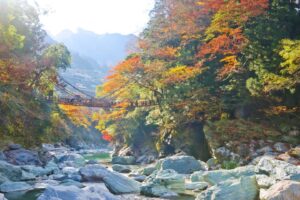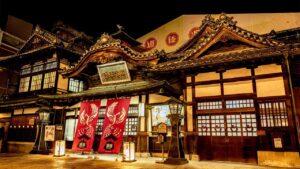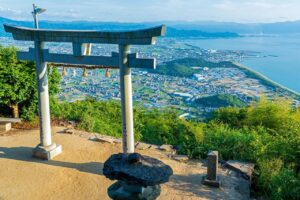Explore Shikoku: Japan’s Hidden Gem
Shikoku is well off the beaten path followed by most travelers to Japan. This country’s fourth-largest island has long evoked a sense of mystery, and even today, visitors embark on a journey of discovery when they venture to Shikoku.
Part of Shikoku’s allure stems from its perceived remoteness and enduring reputation as a hub for religious ascetic practice. For the past 1200 years, Buddhist pilgrims have traversed the island’s 88 Sacred Temples in their quest for enlightenment.
The island encompasses four distinct regions, which is reflected in the name shi (four) and koku (region). Before the era of air travel, boats were the only means to access Shikoku, and it required considerable effort to reach the island until major infrastructure improvements in the mid-1980s.
Today, three substantial bridge systems connect Shikoku to Honshū, complemented by regular flights to the four main cities. With the doors now wide open, visitors around the globe can relish the array of activities Shikoku has to offer. Here’s a listing of the top things to do.
Tokushima Prefecture

Dance at the Awa-odori Festival
Taking place in mid-August, Awa-odori is the largest bon (festival for the dead) dance in Japan. Each year, over a million people flock to Tokushima city to witness dancers rhythmically moving through the streets to the sounds of shamisen (three-stringed guitars), taiko (drums), and fue (flutes). Colorful groups representing villages from throughout the prefecture participate in this four-day event honoring their ancestors.
Explore the Iya Valley
To fully appreciate this rugged, remote valley nestled in the central mountains, having your own transport is essential. Historically, this area served as a refuge for those seeking solace, including the defeated Heike clan after their loss in the 12th-century Gempei wars.
A highlight of the valley includes rivers teeming with kazura-bashi (vine bridges), and the hauntingly beautiful village of Nagoro, adorned with life-size dolls. Additionally, a trail leads to the summit of Tsurugi-san, Shikoku’s second-highest peak.
Cruise into the Naruto Whirlpools
The tides create stunning whirlpools in the narrow strait between Shikoku and Awaji Island, where the Inland Sea converges with the Pacific Ocean off Shikoku’s northeast coast. Visitors can embark on a sightseeing boat for an exhilarating ride through the swirling waters. For a calmer perspective, walk along the Uzu-no-michi Viewing Walkway, suspended beneath the Naruto Bridge, towering 42m (140ft) above the swirling currents.
Ride the cable car to Tairyū-ji
While centuries of walking pilgrims have traversed steep paths to reach the mountaintop Tairyū-ji, Temple 21 of Shikoku’s illustrious 88 temples, modern travelers can enjoy a thrilling 2.7km (1.7-mile) aerial cable car ride from the valley below. Tairyū-ji is infused with history and spirituality, surrounded by towering cedar trees, ancient temple buildings, and pilgrim chants echoing in the air.
Kōchi Prefecture

Discover local cuisine at Hirome Ichiba
The inexpensive culinary scene in Kōchi city revolves around Hirome Ichiba, affectionately dubbed “Kōchi’s kitchen.” This bustling market features around 70 stalls beneath the shadow of the city’s iconic castle. Although it is lively at any time, evenings and weekends offer a vibrant atmosphere as locals gather to savor regional food and drink at communal tables. Be sure to indulge in katsuo-no-tataki (seared bonito), revered as Kōchi’s soul food.
Find enlightenment at Muroto-misaki
Situated on Kōchi prefecture’s southeastern cape, Muroto-misaki extends into the Pacific Ocean, often experiencing fierce waves and storms. When the weather is agreeable, it transforms into a stunning spot, revered as the place where Kōbō Daishi, the founder of Shingon Buddhism, attained enlightenment. Be sure to visit the ancient hilltop temple, Hotsumisaki-ji, as well as the legendary bathing hole amidst rock pools.
Explore Kōchi’s Sunday market
Operative for more than 330 years, Kōchi city’s Sunday street market features 400 stalls stretching east from the main gate at the base of Kōchi castle. Alongside an enticing selection of street food, visitors can find fresh local produce, dried fruit, homemade pickles, and Kōchi-grown green tea. The market also offers unique souvenirs, including hand-forged Kōchi kitchen knives, wooden masks, and fishing-boat flags.
Enjoy Kōchi sake at Tosa-shu Baru
This smoke-free bar, located a street back from Obiyamachi Arcade in Kōchi city, showcases sake from all 18 of Kōchi prefecture’s breweries. The owner, Kōji, is passionate about his selection, presenting three daily-changing nomi-kurabe tasting options accompanied by local delicacies.
Ehime Prefecture

Relax in Dōgo Onsen
Matsuyama city’s Dōgo Onsen Honkan, a 19th-century public bathhouse, sits atop ancient hot springs, made famous by Natsume Soseki’s novel Botchan. It truly is the premier destination for soaking, even amidst renovations scheduled through 2026.
Additionally, two modern bathing complexes can be found nearby. The Dōgo Onsen area is rich with hotels and ryokan, most of which offer their own onsen, and a lively township of arcades leads up to the Honkan bathhouse.
Explore Matsuyama Castle
Perched high above the city on Mt Katsuyama, Matsuyama-jō is one of Japan’s finest remaining castles. Visitors can bypass much of the climb by taking a cable car ride, though the walk offers scenic views. The path weaves through massive stone walls leading into the castle, where wooden stairs and ladders allow for further exploration alongside narrow corridors and historical artifacts.
Ascend Ishizuchi-san, Western Japan’s Highest Peak
Shikoku’s tallest peak offers an enjoyable hike, particularly when encountering Shintō mountain ascetics along the way. Multiple routes lead to the summit: from Nishi-no-kawa, utilizing an aerial ropeway, or from Tsuchi-goya if driving. Adventurous hikers may opt for the kusari routes near the peak, employing steel chains embedded in rocks to navigate steep sections.
Explore Uchiko’s Yōkaichi Historic District
Once celebrated for its fine vegetable wax production, the quaint town of Uchiko features a preserved main street. Visitors can find museums, craft shops, and tea houses framed in charming cream-colored plaster buildings, offering a delightful historic atmosphere. Witness traditional candlemakers at work at Ōmori Wa-rōsoku.
Kagawa Prefecture

Admire Naoshima’s Contemporary Art
North of Takamatsu city and accessible by ferry, Naoshima has risen as a global attraction showcasing Japan’s finest contemporary art. Its museums, designed by acclaimed architect Tadao Ando, display works by renowned artists, including Yayoi Kusama’s Red Pumpkin, pieces by Andy Warhol, David Hockney, and Jasper Johns, along with several of Monet’s iconic water lily paintings. The Art House Project has invigorated a once-neglected area with creative installations by contemporary artists.
Climb to the Inner Shrine of Konpira-san at Kotohira
In conversations about Shikoku, any local will likely inquire if you’ve climbed Konpira-san. This Shintō shrine, dedicated to the god of seafarers, encourages visitors to navigate its 1368 stone steps, commonly regarded as a rite of passage. A bustling town lies at the foot of the climb, providing amenities for visitors. Although the ascent may seem daunting, the striking Shintō gates, serene halls, and captivating views make the journey worthwhile.
Stroll through Ritsurin Park’s Gardens
The renowned Ritsurin-kōen in Takamatsu city is celebrated as one of Japan’s most beautiful gardens. Dating back to the mid-1600s, this “walking garden” was completed over a century for the local daimyō (lord). Visitors can enjoy the serene environment filled with ponds, vibrant carp, bridges, islands, and traditional tearooms. Strolling along winding paths evokes a sense of stepping into the shoes of historical feudal lords.
Savor the Local Delicacy: Sanuki-udon
Sanuki is the former name of Kagawa Prefecture, and although it’s the smallest of Japan’s 47 districts, it is revered for its culinary offerings. Known as udon-ken (udon prefecture), Kagawa is the perfect place to savor udon (thick wheat noodles) served in a flavorful broth. This comforting local dish can be found in numerous establishments throughout the region. Be sure not to leave Kagawa without indulging in a bowl or two.




